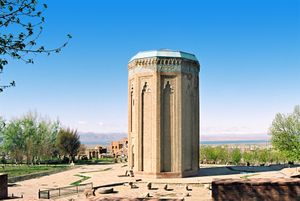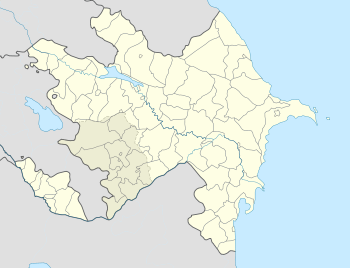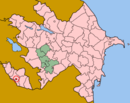Nakhchivan City
| Nakhchivan Naxçıvan |
|||
|---|---|---|---|
| — City & Municipality — | |||
 |
|||
|
|||
 Nakhchivan
|
|||
| Coordinates: | |||
| Country | |||
| Autonomous republic | Nakhchivan | ||
| Area | |||
| - Total | 15 km2 (5.8 sq mi) | ||
| - Land | 14.2 km2 (5.5 sq mi) | ||
| - Water | 0.8 km2 (0.3 sq mi) | ||
| Population (2008) | |||
| - Total | 74,203 | ||
| Time zone | AZT (UTC+4) | ||
| - Summer (DST) | AZT (UTC+5) | ||
Nakhchivan City (Azerbaijani: Naxçıvan şəhəri; also, Nachitschewan, Nakhchyvan, Nakhicevan, Nakhichevan’, and Nakhjavan), is the capital of the Nakhchivan Autonomous Republic of Azerbaijan, located 450 km west of Baku. The municipality of Nakhchivan consists of the city of Nakhchivan and the villages of Başbaşı, Qarağalıq, and Daşduz.[1] It is spread over the foothills of Zangezur chain, on the right bank of the Nakhchivan river at an altitude of almost 1000 m.
Contents |
Etymology
According to official versions, the name Nakhchivan derived from the Persian Naqsh-e-Jahān ("Image of the World"), a reference to the beauty of the area.[2][3] The medieval Arab chronicles referred to the area as "Nashava".[4] The Greeks and Romans called it Naxuana.
History
The Brockhaus and Efron Encyclopedic Dictionary notes that according to legend the city of Nakhchivan was founded by Noah , and the date of the town on the Persian sources in 1539 BC.[5]
In the 2nd century, Nakhchivan was already known to Ptolemy under the name Ναξουὰνα. Iranian historian and geographer of the fourteenth century Hamdollah Mostowfi in his book Nuzhat al-kulub (hearts delight), believed that Sassanid Iranian military commander was the founder of Nakhchivan , who lived in the end of VI century.[6]
At the end of the eighteenth century, city became the capital of independent Nakhchivan khanate.
Economy
Traditionally, Nakchivan was home to trade industry, handicraft, shoemaking and hatting. These industries have been largely replaced. The restoration enterprises and development industry, liberalization of foreign trade and the extension of the customs infrastructure, which has been largely responsible for Nakchivan's growth in the last two decades, are now major parts of Nakchivan's economy.[7]
Culture
The city has a wide range of cultural activities, amenities and museums.
Cuisine
Nakchivan’s signature cuisine includes plov with gravy (made with mutton, hazel, almond and dried fruits), dastana, komba, tendir lavash and galin.[8]
Museums and galleries

The main sight in the city is the heavily restored 12th century Momine Khatun Mausoleum, also known as 'Atabek Gumbezi'. Momine Khatun was the wife of Eldegizid Atabek Djakhan Pakhlevan, ruler of the Atabek Eldegiz emirate. The 10-sided monument is decorated with intricate geometrical motives and Kufic script, it uses turquoise glazed bricks. It shares the neighbourhood with a statue of its architect - Ajami Nakhchivani - and a bust of Heydar Aliyev. Also from the 12th century and by the same architect, is the octagonal Yusuf Ibn Kuseir tomb, known as Atababa, half abandoned near the main cemetery.
More recent (1993) is the white marble mausoleum of Hussein Javid. The Azeri writer died in the Gulag under Stalin. Both the mausoleum and his house museum are located east of the theatre. Although being a recent construction, Huseyn Javid's mausoleum is of great iconic importance, representing the ability of the exclave to live despite the Armenian embargo and becoming a symbol of Nakhchivan itself.
The city also has many historical museums, the literature museum of Nakhchivan Autonomous Republic, Nakhchivan State History Museum, The Nakhchivan State Carpet Museum, and the house museums of Jamshid Nakhchivanski and Bahruz Kangarli.[9] There is also an archeological museum on Istiqlal street. The city has a few interesting mosques, particularly the Juma mosque, with its large dome.
Modern museums in Nakchivan include the museum under Open Air, and along the memorial museum and Heydar Aliyev museum.
Transportation
Nakhchivan Airport (NAJ), in the north of the city, serves a number of domestic and international destinations including Iran, Turkey and Russia.
Currently, light rail line is working from Nakchivan to Ordubad beyond to Sharur.[10]
Education
There are 3 professional, 6 musical, 22 secondary schools and a military cadet school in Nakchivan administered by the city council.[11]
Universities and colleges
Nakchivan is one of the Azerbaijan's main centre of education and home to numerous universities:
- Nakhchivan State University
- Nakhchivan Private University
- Nakhchivan Teachers Institute
Sports
Football and Futsal are the most popular sports in Nakhchivan. The city's Araz Naxçivan is one of the top futsal clubs in the European futsal arena and regularly participates in UEFA Futsal Cup.[12][13][14]
Sister cities
Notable people
- Heydar Aliyev, former president of Azerbaijan
- Jalil Mammadguluzadeh, writer
- Huseyn Javid, poet
- Bahruz Kangarli, artist
- Huseyn Khan Nakhchivanski, Cavalry General and General-Adjutant of the Emperor of Russia
- Ajami Nakhchivani, architect
- Malahat Nasibova, Rafto Laurate 2009
Gallery
 Monument of Ajami Nakhchivani |
Khan Palace of Nakhchivan |
 Face Pattern of the Momine Khatun Mausoleum |
 Hotel Tabriz, 5 star |
 Monument of Jalil Mamedkulizadeh |
 Nakhchivan City coat of arms under Imperial Russia (designed in 1843) |
Youth centre of Nakhchivan City |
.jpg) Rug in House-Museum of Huseyn Javid |
 Nakhchivan State Theatre |
 House-museum of Jamshid Nakchivansky |
 Nakhchivan Airport |
 The aerial view of the city |
References
- ↑ Belediyye Informasiya Sistemi
- ↑ (Russian) Hamdollah Mostowfi. Nozhat al-Gholub
- ↑ (Russian) Evliya Chelebi. Seyahatname
- ↑ Ibn Khordadbeh, Book of Roads and Kingdoms (al-Kitab al-Masalik w’al-Mamalik).
- ↑ Энциклопедический словарь Брокгауза и Ефрона. Нахичевань. — С.-Петербург:1890—1907 (Russian)
- ↑ УСЛАДА СЕРДЕЦ (Russian)
- ↑ The economy of Nakchivan
- ↑ National cuisine of Nakchivan
- ↑ The Museums of Nakchivan City
- ↑ Transport of Nakhchivan
- ↑ The Secondary Schools in Nakchivan
- ↑ Футзальный клуб «Араз» определился с соперниками по элитному раунду Кубка чемпионов (Russian)
- ↑ Happy Friday night for Benfica, Puntar and Araz
- ↑ Club's uefa.com profile
External links
- Nakhchivan Guide
- Nakhchivan Portal
- Nakhchivan (as Naxçıvan) at GEOnet Names Server
- World Gazetteer: Azerbaijan – World-Gazetteer.com
|
|||||||||||
|
|||||||||||

